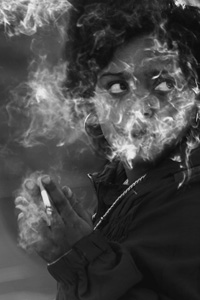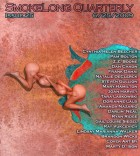One of my favorite images here is that folded paper towel at the end, evoking the “origami paper” of the opening. What is your process for creating such connections between and among the images? When I read poetry, that connection feels akin to the “narrative” of story.
Thank you, I hadn’t even noticed. I know that’s a terrible answer, but it’s the truth. There are times when I do connect images with purpose, and I remember trying to get the blue smoke, the neon letters, the sun coming in through hair to play with and against the bathroom’s fluorescent lights. The ambiance of light vs. dark in bars is so compelling, so much of the allure, and I wanted to try to get at that. But the origami and the folded napkin seem to have been a happy accident. Also, this “story” was once a failed poem. I pulled the poem out of lines and re-worked it, so many of the more poetic images were already in place. When I write a poem, I tend to follow and build on sound or image. I sent Meg Pokrass a draft of the piece and she made some wonderful cuts which helped the images cling together.
Oh, you can’t write about women in bars. Don’t you know that?
Thank you for making an exception! You know, it’s lucky for me that I didn’t know. I remember Li-Young Lee once saying he was grateful he didn’t know that writing about roses was a cliche or he never would have written what I think is his finest book of poetry, Rose. But there is something so powerful and vulnerable about a woman in a bar, and something so intimate and sacred about two women in a bathroom: a closed world within a closed world. I wanted to paint both of those small universes.
I so love (and admire) the surprises of language, the way spaghetti appears with neon letters, the bodies with olives, the motes with hair. Have you always seen the world in such a way? Is this vision something that can be learned? If so, how might you go about teaching it?
Again, I have to go back to the idea of painting. I simply wanted to reproduce the beauty and ruin of a woman in a bar. I grew up with women in bars. My mother was a drinker, and as a result many of my female friends have been drinkers, so I know that life well. I ask my students to observe without judgment, and then to try to feel that observation through language, through metaphor, to be alert to the particular. And to practice description daily, as a painter would, looking for shape and color and the interplay between shadow and light.
“Newly coherent” and “smooth as the sink.” What else could one want in a lover? From where do these people arise in you? Out of your experience or your wishes for them? (They’re so real, desire made incarnate).
The woman in the bar of my story is an amalgam of a number of women I’ve known and loved. I’ve spent a lot of time in the heated atmosphere of bars and it’s a heady brew. And because I was often the only sober person there, maybe I saw things as the outsider or interloper, the witness, which seems a good position to be in when telling a story. People who love people who drink are in a no-win situation. Who can compete with booze? Liquor is so gorgeous, so desirable: the bottles, the woody, ruddy colors, the ropey thickness of the liquid, the scent that rises from the delicate rim of a glass. Rows and rows of powerful potions lined up on the shelves, waiting to be chosen. I wanted to show the supplicant’s role in all that. To me, it’s interesting that the drinker is on her knees, but really it’s her friend who is kneeling to “the woman in a bar”. She gazes upon her the same way her friend gazes at the booze. Both are utterly devoted.
Tell us all you can about your current projects, writing and otherwise.
I’ve just completed a manuscript of new poems called The Book of Men I hope to revise this summer. I also have a second chapbook coming out from Red Dragonfly Press called Dark Charms.
I want to take this opportunity to thank you all or inviting me to become a part of SLQ. I feel privileged to be among you.



 The core workshop of SmokeLong Fitness is all in writing, so you can take part from anywhere at anytime. We are excited about creating a supportive, consistent and structured environment for flash writers to work on their craft in a community. We are thrilled and proud to say that our workshop participants have won, placed, or been listed in every major flash competition. Community works.
The core workshop of SmokeLong Fitness is all in writing, so you can take part from anywhere at anytime. We are excited about creating a supportive, consistent and structured environment for flash writers to work on their craft in a community. We are thrilled and proud to say that our workshop participants have won, placed, or been listed in every major flash competition. Community works.